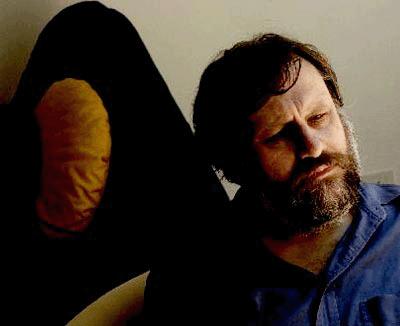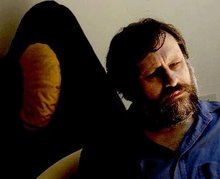Frankfurter Rundschau 1/03.
The State of Emergency Called Love lacanian ink 21, Spring, pp 72-83.
lacan.com
in Rosemarie Trockel, Institut f?landsbeziehungen,
Verlag der Buchhandlung Walther König, Köln
In These Times, March 26.
Paranoids Reflections
LRB, 3 April.
interview with Eric Dean Rasmussen,
University of Illinois at Chicago, September 29.
In These Times, 6 June.
Columbia University, 04/14.
How a philosopher from Slovenia became an international star
Rebecca Mead, The New Yorker, May 5.
LRB, May 22.
lacan.com
lacan.com
lacan.com
lacanian ink 22, Fall, pp 124-139.
Not a desire to have him, but to be like him
LRB, 21 August.
Parallax
LRB, 20 November.
Journal Of Ayn Rand Studies
Issue 95, INTERNATIONAL SOCIALISM JOURNAL,Summer
lacanian ink 20, Spring, pp 100-113.
Critical Inquiry, Winter.
The Symptom 2, Spring.
The Real of Sexual Difference
in Barnard, S. Fink, B., Reading Seminar XX, New York: SUNY>
Revolution Must Strike Twice
LRB, 25 July.
LRB, July 25.
LRB, May 23.
lacan.com
Diacritics 31.1 (2001) 91-104
lacanian ink 18, Spring, pp 80-107.
On Belief (2001).
lacan.com
Rethinking Marxism, vol. 13, no. 3/4.
lacanian ink 19, Fall, pp 82-103.
lacan.com, September 17.
Die Gazette, Israel, 08/27.
Interview, Spiked, November 17.
European Graduate School
lacanian ink 16, Spring, pp 64-81.
New Left Review 2, March-April, pp 37-45
lacan.com
Postface: Georg Lukács as the philosopher of Leninism
in Lukács G., A Defence of History and Class Consciousness,
London: Verso.
Lacan between Cultural Studies and Cognitivism
Umbr(a), pp 9-32.
lacanian ink 17, Fall, pp 78-99.
The National Interest, Washington, Winter.
lecture transcript, EGS, August 1999
lacanian ink 14, Spring, pp 26-40.
Lunds Universitet, December 15.
Mainview, September.
LRB, March 18.
lacan.com.
Slavoj Zizek's: "The Spectre Is Still Roaming Around"
A Conversation with Slavoj Zizek.
Nettime, June 29.
lacanian ink 15, Fall, pp 98-107.
Inside the Matrix: International Symposium,
Center for Art and Media, Karlsruhe, October 28
lacan.com
LRB, October 28.
New Left Review 238, Nov.-Dec., pp 26-47
Olin Auditorium, Bard College, November 16.
lacanian ink 12, Spring, pp 58-69
Arkzin: Zagreb 1998
The South Atlantic Quarterly; Durham; Spring 1998..
Journal of Political Ideologies, February
Centre Georges Pompidou, Paris, Traverses
French version
Risk society and its discontents
Historical Materialism 2, pp 143-64.
Critical Inquiry, Summer
The South Atlantic Quaterly, Spring
Umbr(a), 1998
.
lacanian ink 13, Fall, pp 12-25.
Interview with Slavoj Zizek.
The Supposed Subject Of Ideology
Critical Quarterly, Summer, pp 39-59.
lacanian ink 11, Fall, pp 12-25.
Journal of European psychoanalysis, Spring-Fall.
New Left Review 225, Sept.-Oct., pp 28-51.
Umbr(a), pp 147-152.
Independent Media Center, Israel.
Re-visioning "Lacanian" social criticism: The Law its obscene double
Journal for the Psychoanalysis of Culture Society 1.
There Is No Sexual Relationship, Wagner As A Lacanian
New German Critique, Fall, pp 7-35.
lacanian ink 10, Fall, pp 24-39.
interview by Geert Lovink, Inter Communication no. 14
The Audiovisual Contract - Noise Surrounding Reality
Deutsche Zeitschrift fur Philosophie, pp 521-533.
interview by Josefina Ayerza, Lusitania vol.II no.4
Kant As A Theoretician Of Vampirism
lacanian ink 8, Spring, pp 19-34.
P. Canning in Artforum, March, pp 84-89.
The Inner Civilization Of Human Rights (Slovenia) And The Other Barbarism (The Rest Of The Balkans)
Du-Die Zeitschrift der Kultur, pp 26-28.
Hegels Logic As A Theory Of Ideology
lacanian ink 7, Spring, pp 29-48.
From Courtly Love to The Crying Game
New Left Review 202, Nov.-Dec., pp 95-108.
Ljubljana, 1993.
Josefina Ayerza in Flash Art, March-April, pp 68-70.
Eastern European Liberalism And Its Borderlines
Oxford Literary Review, pp 25-44.
The Ideological-Practical Core Of The Fundamental Operation In Hegel's Logic Of Reflection
Filosofski Vestnik-Acta Philosophica, pp 9-25.
Cogito And The Sexual Difference
American Journal of Semiotics, pp 5-32.
The Guardian, Manchester, August 28
lacanian ink 6, Fall, pp 25-42.
Kant - The Subject Out Of Joint
Filozofski Vestnik-Acta Philosophica, pp 233-248.
lacanian ink 2, Winter, pp 9-28.
Formal Democracy And Its Discontents
American Imago, pp 181-198.
Grimaces of the Real, or When the Phallus Appears
October 58, Fall, pp 44-68.
Eastern Europe Republics Of Gilead
New Left Review 183, Sept - Oct, pp 50-62.
Rossellini: Woman As Symptom Of Man
October, Fall, pp 18-44.
Death And Sublimation: The Final Scene Of City Lights
American Journal of Semiotics, pp 63-72.
The Logic Of The Detective-Novel
Pamietnik Literacki, pp 253-283.
The Detective And The Analyst - The Shift From Detective-Story To Detective-Novel In The 1920s
Literature and Psychology, pp 27-46.
Excerpt from The Sublime Object of Ideology
(London; New York: Verso, 1989), pp. 28-30.
Looking Awry - Pornography
October, Fall, pp 31-55.

 Still from The Reality of the Virtual
Still from The Reality of the Virtual Poster for Zizek!
Poster for Zizek! Still from Pervert's Guide
Still from Pervert's Guide 




















 1
1

























